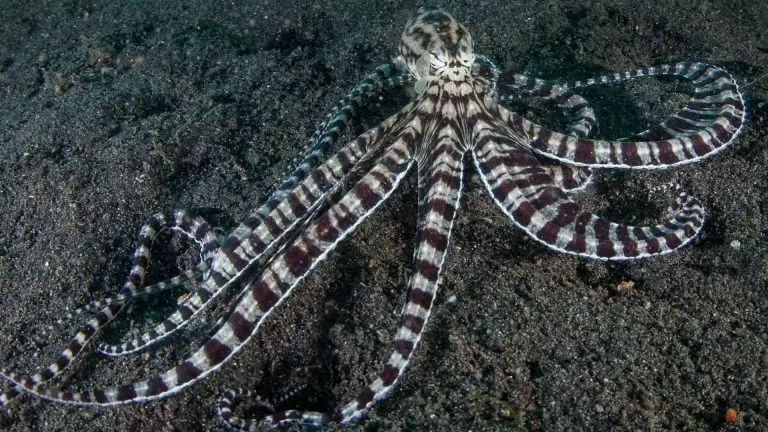“Poppa! Have you seen the Mimic octopus?”
My oldest granddaughter’s question was lit with excitement. I had been mentioning a presentation I was working on featuring animals with incredible design features, highlighting that some of them were incredibly difficult for evolutionists even to begin to explain. When I mentioned squid and octopus camouflage, her question above popped out.
My response of “I don’t think so” initiated a frantic scramble for a nearby phone and a hasty search on YouTube. What I watched for the next minute and forty-nine seconds1 left me with my mouth agape and led eventually to a salt-water aquarium in my home with one of those very creatures inhabiting it. (It’s amazing what homeschoolers learn about!)
Like a second skin
Even the “average” octopus species is truly incredible, capable of rapid color changes a chameleon could only dream of. Like a pixelated video screen, flashes of light can erupt from their skin surface, sometimes pulsating and other times creating waves of shadowy patterns that make them almost impossible to spot along the ocean floor among its corals and sea plants. They are capable of texture changes to their skin that are downright eerie, which means not only can they simulate the color of objects in their surroundings but also the shape of them to an extent.
Rather than describing these creatures’ sophistication and complexity as simply a reflection of the brilliance and glory of their Creator, some naturalists have attempted to explain some of their intricacies as being alien in origin. So “advanced” are these creatures’ abilities (and yet so early do they appear in the evolutionary timeline, supposedly 296 million years ago2), some evolutionary scientists have seriously suggested they perhaps had biological input from alien lifeforms at some point in their “evolution”!3

The mimic octopus’s most impressive copying act is its take on the flounder. It even undulates across the ocean floor just like the founder does.
Why do you act that way?
But as amazing as “regular” octopi are, the mimic octopus is in a class by itself: it’s the first living thing ever observed to impersonate the shape and behavior of other aquatic species along with color and texture changes. Discovered in 1998 off the coast of the island of Sulawesi (Indonesia), it’s been spotted now as far as the Great Barrier Reef in Australia, so may be more widespread than originally thought.4 Many of the creatures it imitates are venomous, so it fools predators into thinking they are encountering a dangerous adversary rather than a sly cephalopod.
The exact number of creatures it’s able to mimic is unknown, but watching video of one hide its body and six legs in a hole, change the color of its two exposed arms to the distinctive black and light stripes of the banded sea snake, and then waving them in opposite directions to impersonate a striped serpent is unnerving to say the least! Known “avatars” the mimic imitates include flatfish, crabs, jellyfish, mantis shrimp, stingrays, lionfish, and sand anemones.
The uncanny thing about these octopi is that they seem to be able to make accurate and intelligent decisions as to what creature they should imitate depending on the environment they are in or the predators they encounter. For example, because damselfish are hunted by banded sea snakes, mimics often adopt their “snakelike” form, color, and behavior when they encounter damselfish to frighten them away. When traveling across a seabed with little cover, mimics may transform their tentacles to look like the poisonous barbed fins of a lionfish and imitate its pulsing, distinct movement so as to ward off predators.

The mimic octopus will burrow down, leaving just two of its tentacles visible, to do a decent impression of the banded snake eel, on the right.
The quick-change artist
When considering this creature’s day-to-day activity, you quickly realize it has several sophisticated abilities that depend on accessing and activating tremendous amounts of coded, genetic information.
- Sensor array: Obviously, the mimic must be capable of monitoring and analyzing its current environment constantly.
- Response analysis: It must also have the ability to determine an appropriate response(s) needed in different environments or when encountering specific predators it interacts with. (I.e., if A, then B; if X, then Y, etc.).
- Catalog of aliases: Once a specific creature to mimic has been decided upon, it must then access other detailed “files” for all of the abilities, features, and behaviors of the different creatures it can possibly mimic.
- Immediate response: The mimic’s systems must then correctly activate commands to alter its shape, color, texture, and movement, which of course requires a body that has the capability to expand or contract, become smooth or rough, rigid or soft, multi-textured, multi-colored and/or precisely patterned almost instantaneously.

The pic on the left doesn’t capture the mimic’s best lionfish imitation but gives a feel for how it can masquerade as the poison-tipped predator on the right.
Meet “Morph”
I named my own mimic, procured from a local pet store, Morph. Morph lived for eight months, but he exhibited spectacular behavior and executed many brilliant performances during that time, with nightly “light shows” being commonplace. Although very shy for the first three days I had him, he became more comfortable, and I was able to hand-feed him shrimp for his supper eventually.
Because octopus aquariums are typically a one-species environment (either the octopus eats whatever else is in there or they get eaten by what is), he only “mimicked” once, as there was nothing in the tank to react to. Upon entering my tank for the very first time, Morph impersonated a jellyfish, slowly pulsed down, and then switched to his regular form once he had cover. This made sense, because upon entry he was at the top of the tank with nowhere to hide and didn’t know if there were predators in that environment.
Note that his mimicry involved imitating another creature not immediately present in his environment (rather than simply blending into the background), which leads to the question, how did he “know” what to do? Mimic octopi are only thought to live nine months (the longest-living octopus live for a maximum of five years), so scientists don’t believe they are simply observing and copying other creatures’ behavior; they are born with it. Which means all of that programming is already present and passed on to each subsequent generation. But how could that have come about?
Masterful design
Consider this: If a person today were to create and program a mechanism that could perform half the functions this creature does, they would likely receive all of the accolades the scientific community could possibly bestow upon a human being, and probably hail them as the most brilliant scientist on the planet. Their creation would be highly esteemed as an incredible example of intelligent design. However, despite the obvious evidence of design in nature, naturalists seem bound to evolutionary interpretations. One evolutionary blogger from Nature.com tried explaining the mimic this way:
“In this species we see the evolutionary ‘perfect storm’ in which a species with flexibility in their skin and body shape is consistently exposed to a predator-rich environment that contains toxic or venomous species such as soles, lionfish and banded sea snakes. This combination provides both the selective pressures and the opportunity to these otherwise vulnerable animals to evolve into the world’s greatest masters of disguise!”5
But that isn’t a real explanation of anything. It’s like saying because evolution is true, evolution happened. But design requires a designer, and programming requires a programmer. Natural selection or genetic mutation are simply not sufficient explanations for what we see in creatures like the mimic octopus. And despite evolutionists concocting many “just so” stories to attempt to explain how so many precisely coordinated and irreducibly complex mechanisms could have arisen in creatures without a designer, for those with eyes to see, the conclusion is obvious.
“But ask the beasts, and they will teach you; the birds of the heavens, and they will tell you; or the bushes of the earth, and they will teach you; and the fish of the sea will declare to you. Who among all these does not know that the hand of the Lord has done this?” (Job 12:7-9)
The master designer, the God of the Bible, created these along with all of the other magnificent sea creatures on day five of creation. As much as evolutionists try to mimic God’s creative power through the story of evolution, creation declares its Creator, even in an insignificant octopus!
Be sure to check out the 3-minute video below.
Footnotes
1 Most intelligent Mimic Octopus in the world, https://www.youtube.com/watch?v=t-LTWFnGmeg
2 Rachel Nuwer, “Ten Curious Facts About Octopuses,” Smithsonian Magazine, October 31, 2013, https://www.smithsonianmag.com/science-nature/ten-curious-facts-about-octopuses-7625828.
3 E. Steele, et al., “Cause of Cambrian Explosion—Terrestrial or cosmic?” Progress in Biophysics and Molecular Biology136 (2018):3–23, doi:10.1016/j.pbiomolbio.2018.03.004.
4 “The Mimic Octopus,” National Geographic, www.nationalgeographic.com/animals/invertebrates/m/mimic-octopus.
5 Sarah Jane Alger, “The Mimic Octopus: Master of Disguise,” October 28, 2013, https://www.nature.com/scitable/blog/accumulating-glitches/the_mimic_octopus_master_of.
Picture credits from top to bottom: VelvetFish iStockPhoto; VelvetFish iStockPhoto.com; FtLaud Shutterstock.com; Stephan Kerkhofs, MariusLtu, Jenhung Huang, and Vitalii Kalutskyi, all iStockPhoto.com
This article was written by Calvin Smith [Executive Director and Speaker for Answers in Genesis CA], is published with permission, and originally appeared at https://answersingenesis.org/blogs/calvin-smith/2020/09/07/masters-disguise.












